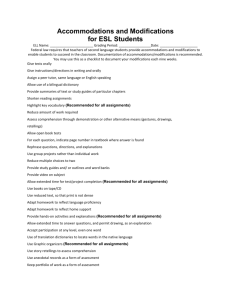Classroom Accommodations Ideas
advertisement
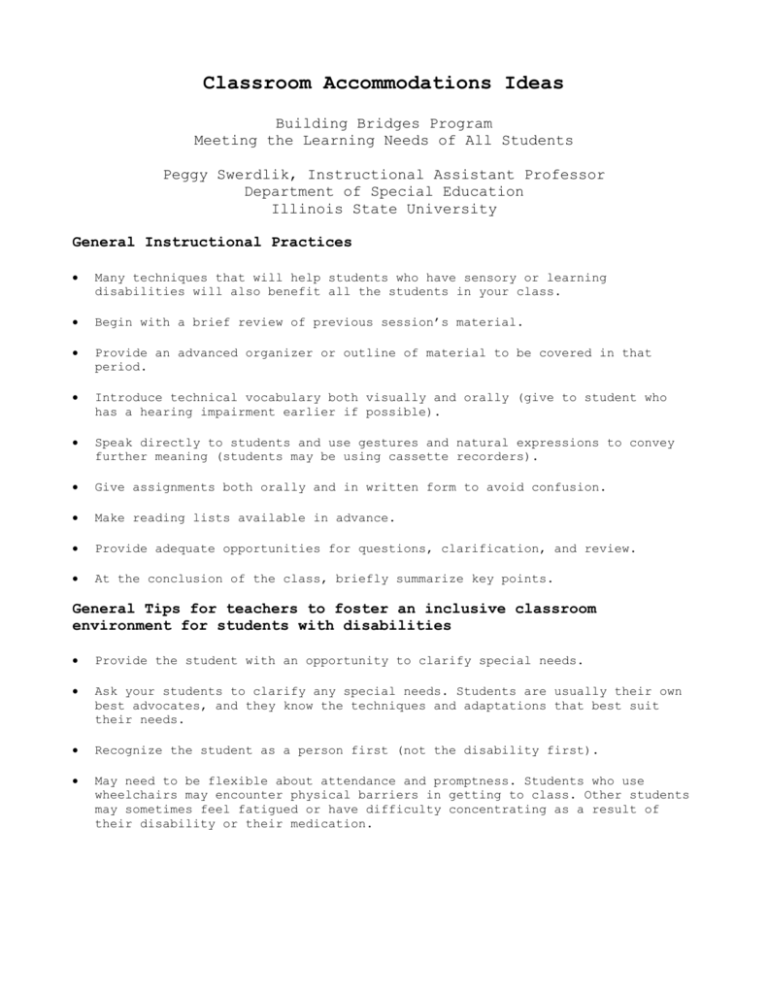
Classroom Accommodations Ideas Building Bridges Program Meeting the Learning Needs of All Students Peggy Swerdlik, Instructional Assistant Professor Department of Special Education Illinois State University General Instructional Practices Many techniques that will help students who have sensory or learning disabilities will also benefit all the students in your class. Begin with a brief review of previous session’s material. Provide an advanced organizer or outline of material to be covered in that period. Introduce technical vocabulary both visually and orally (give to student who has a hearing impairment earlier if possible). Speak directly to students and use gestures and natural expressions to convey further meaning (students may be using cassette recorders). Give assignments both orally and in written form to avoid confusion. Make reading lists available in advance. Provide adequate opportunities for questions, clarification, and review. At the conclusion of the class, briefly summarize key points. General Tips for teachers to foster an inclusive classroom environment for students with disabilities Provide the student with an opportunity to clarify special needs. Ask your students to clarify any special needs. Students are usually their own best advocates, and they know the techniques and adaptations that best suit their needs. Recognize the student as a person first (not the disability first). May need to be flexible about attendance and promptness. Students who use wheelchairs may encounter physical barriers in getting to class. Other students may sometimes feel fatigued or have difficulty concentrating as a result of their disability or their medication. Classroom Accommodations and Suggestions for Students with Hearing Impairments Students with hearing impairments need to use note takers in class. They must spend class time watching instructors and interpreters so are unable to also take notes. In most cases, other students in class are willing to share notes. You may be asked to help locate volunteers. Discuss with your student where it would be best for him/her and the interpreter to sit in the classroom. The optimum situation would be for the interpreter to be near the instructor and for the student to be in the front of the room for a clear view. Try not to lecture with your back to the class (when writing on the board) because it destroys any chance of your student getting facial or lip reading cues. Using an overhead projector often alleviates this problem. When questions are being asked from the class, it would help if you would repeat the question before answering it. Be aware that your student with a hearing impairment cannot look at you or the interpreter and do other work at the same time. Allow enough time for students to study printed material (such as handouts, charts, and over-heads), fill out paperwork, or complete the task/step you’ve just described before continuing. Feel free to call upon your student with a hearing impairment in class, as you would do with any other student. Using visual materials is helpful to supplement and reinforce what is being said. If the room lighting must be reduced, check to see that sufficient light is available for the student to see the interpreter’s signs and lip movements. Get your student’s attention before beginning to speak. This may necessitate physical contact, such as a tap on the shoulder. Use open-ended questions, which must be answered by more than “yes”, or “no.” Don’t assume that your student has understood your message if only required to nod in acknowledgement. Open-ended questions ensure that your information has been communicated. Testing Accommodations and Suggestions for Students with Hearing Impairments Your student with a hearing impairment may have a great difficulty understanding questions on a written exam due to English syntax, idiomatic language, or vocabulary used. Allow the interpreter to sign each question so that your student may fully comprehend the question being asked. Classroom Accommodations for Students with Visual Impairments Students may need textbook information at least eight weeks prior to the term so that they may make taping arrangements with outside resources. Visual aids during lectures can be adapted by using clear descriptions of the visual material presented. This would include verbalizing what is being visually presented on the overhead/slide. Due to the time needed to schedule a reader/writer, “pop quizzes” require planning. Give verbal as well as written notice of room or homework changes, special meetings, or assignments. Preferential seating is important for the student. When visual cues are not available, the student must receive all auditory cues possible. Be sure all handouts and tests are typed clearly in dark print. For students with low-vision contrast, print-style, and spacing are very important. Orient your student to the room by explaining where things are located around the room and inform your student when classroom furniture has been rearranged. Keep doors fully open or closed. Don’t assume your student will recognize you by your voice even though you have met before. Identify yourself by name, maintain normal voice volume, speak directly to the person, and maintain eye contact. Testing Accommodations for Students with Visual Impairments Allow your student and reader to work in a room where they will not disturb or be disturbed by others. Try to avoid long questions and multiple-choice options that confuse students. Only use graphs or charts on exams that have already been introduced in class. Enlarge the test questions for those students with some vision capabilities. Classroom Accommodations for Students with Learning Disabilities Allow students to tape record lectures. Students who have difficulty with printed symbols may need to use tape-recorded textbooks to listen and read simultaneously. They may need to contact you well in advance to get textbook information and a schedule of reading assignments in order to make taping arrangements. Some students are unable to communicate effectively through writing. Their work may appear careless, or they often write out their thoughts quite slowly. They may be able to demonstrate learning better by dictating their ideas to a writer, tape recording their reports, or having a time extension on due dates. Extra time may be needed to complete longer or more detailed assignments. Students may ask you to repeat instructions or appointment details to ensure that the information is correct. Students may need assistance in locating a volunteer classmate to share notes. When they don’t have to focus on taking notes, they can concentrate on what is being said in class. Testing Accommodations for Students with Learning Disabilities Keep physical transferring of information to a minimum. Allow your students to write answers on the test itself rather than having to record answers on a separate sheet. Scantron forms are especially difficult to use for students with tracking difficulties. Circling or checking answers would be the best alternative. Vocabulary used on tests should have been used in class. Classroom Accommodations for Students with Mobility Impairments Students with limited hand use may need assistance in locating a volunteer classmate to share notes or to help with class activities. Assignment due dates may need extensions if students have limited hand use. When talking to your student who is in a wheelchair and the conversation continues for more than a few minutes, it is helpful to sit down, kneel, or squat if convenient. Communication may be enhanced and neck strain alleviated. Feel free to use words such as “walking” or “standing” in conversation; people in wheelchairs use the same words. If students’ speech is difficult to understand, ask to hear it again. Also, allow students to speak for themselves and complete the communication; never do it for them. Your student may be a few minutes late to class if the class before yours is on the other side of the campus or if the accessible route is out of the way. Occasionally students will have a dog helping them. Since these are working animals, it can be hazardous for them if the dog is distracted. Check for the owner’s preference before petting the dog. Test Accommodations for Students with Mobility Impairments Time extension (time and a half or doubled). Students who have difficulty writing may require the assistance of a test writer word processor with special adaptive equipment. Due to the time needed to make arrangements, “pop quizzes” require special planning, either your student must be given prior notice of tests. Exams may need to be divided into several sections if the student is easily fatigues. Students using wheelchairs may need a raised workspace to complete their exams. Be Aware of “Hidden Disabilities”!! Learning disabilities Learning disabilities hinder students of average or above-average intelligence from easily and dependably processing various types of information. In general, using a variety of instructional modes enhances learning for such students, as it does for all students, by allowing them to master material that may be inaccessible in one particular mode. Mild to moderate sensory impairments Mild to moderate sensory deficits (low-level vision, slight hearing impairment) should be accommodated by appropriate seating and room lighting. Chronic illness Chronic disabilities (diabetes, seizure disorders, cardiac or respiratory conditions, lupus, cancer, AIDS) may interfere with stamina, attention span, and alertness. The attendance and performance of affected students may be erratic, and they may need flexibility in the scheduling of assignments. Fostering class participation Arrange for class participation or an alternative method. Students who cannot raise their hand to answer or ask questions may feel isolated or ignored in class. During your first private meeting with such a student, ask how he or she wishes to be recognized in the classroom. Some students will want to be called on; others may prefer to meet periodically with you before or after class to ask questions about course content. Typical Mathematics Adaptations Pocket calculators for computations. Half-inch graph paper to help the student to align mathematics problems. Highlighted or underlined key words, function signs, and related quantities. Short assignments that address one concept in a variety of ways and provide extensive practice. Self-correcting materials to provide instant feedback in regard to accuracy. Peer or professional tutors or a study group that is composed of other class members who have been successful in the approaches. Tape recorded reviews of important topics. Test retakes and averaging the two test scores. Typical Test Taking Adaptations In class discussion directly address student not the interpreter. When talking to a student in a wheelchair for more than a minute or two, it is best to sit down so that you can talk at eye level. Repeat comments or questions from classmates (let the student know who is speaking). When a student is speaking out of the range of vision of student who has a hearing impairment repeat the question or comment and indicate who is speaking (by motioning) so the student can follow the discussion. To accommodate students with visual disabilities, identify by name the student who is speaking or identify the person to whom you are speaking. Listen attentively when a student with a speech disability is speaking. Never pretend to understand if you are having difficulty doing so. Instead, repeat what you have understood and allow the student to respond. Provide for alternative methods for oral presentations, if necessary. Physical Access Ensure classroom access and seating needs. Ensure access to out of class activities. ADAPTATIONS OF ASSIGNMENTS If Student has Difficulty Reading Textbooks o o o o o o o o o o o o o o Find a text written at a lower level Adapt the student’s text by highlighting and reorganizing Rewrite the student’s text Tape the student’s text Allow student or parent to read text aloud to student Shorten the amount of required reading Look for same content in another medium (movie, filmstrip, tape) Have class read aloud in small groups on a volunteer basis, being certain reader with a disability can contribute some other way later. Allow extra time for reading. Limit reading requirements. Substitute study guides which identify key ideas and terms as the only reading assignment. Motivate – interest students in the subject. Use worksheets which ask for information teacher wants learned and provide page numbers. Put main ideas of text on index cards which can easily be organized in a file box divided by chapters. If Student has Difficulty Reading Study Sheets or Tests o o o o o o o o o Tape record the questions or give oral tests. Use more site space between sections. Provide a buddy or allow group help. Make test more manageable; reorganize for clarity. Pre-teach vocabulary. Reduce the vocabulary level. Type worksheets rather than write by hand for easier reading. Give a take-home test. Use larger type. If Student has Difficulty Understanding What is Read o o o o o o o o o o o o Reduce the language level Become more concrete by using manipulatives and pictures. Reduce amount of new ideas introduced at one time. Provide experience before and after reading as a form of reference for new concepts. Stimulate. Relate to previous experience or something student already knows. Provide study guides. Provide categorical cues. Give organizational help. Teach student to visualize what is read via role playing or providing descriptive passages for practice. Provide alternative media (using a film instead of a lecture) Add additional input source (put text on tape so student can hear what is read). Environmental Strategies o o o o o o o o o o o o o o o Use study carrels. Use proximity seating. Seating arrangements in horseshoe (2-3 rows deep) Preferential seating based on individual needs. Frequent changes in assigned seating. Build rapport with students during the “before-school” time with informal talk and music. Groups of Four philosophy adopted from cooperative learning practices. Assign a peer tutor or utilize cross-age tutoring to review information. Seat students in area free from distractions. Let student select the place which is best for student to study. Student seated near someone who will be helpful and understanding. Help keep student’s space free, of unnecessary materials. Use checklists to help student get organized. Use notebook for organized assignments, materials, and homework. Provide opportunities for movement. Organizational Strategies o o o o o o o o o o o Provide list of materials needed at the beginning of each grading period. Post assignments and class activities in the same place each day and explain verbally. Help student use a monthly calendar. Provide structured format for journal/notebook entries and illustrate the format with each focused assignment. Use daily journal. Ask students to repeat directions. Provide structure with timelines for completion of each part of long assignments. Give parents information about long-term assignments. Use color coding to focus attention. Establish daily routine and attempt to maintain it. Make clear rules and be consistent enforcing them.
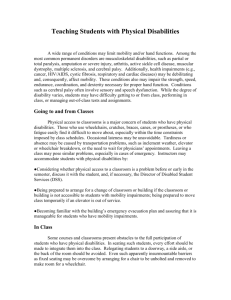

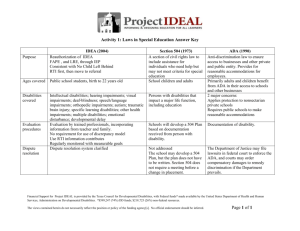


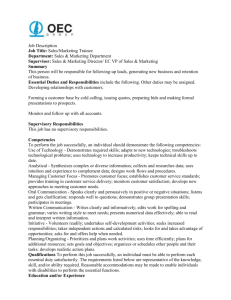
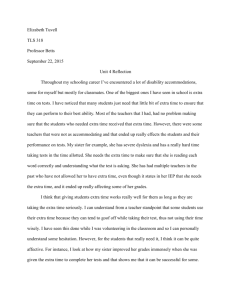
![Syllabus [Word]](http://s3.studylib.net/store/data/006967311_1-8dc868a12812e520f131dbbe02cc269a-300x300.png)
